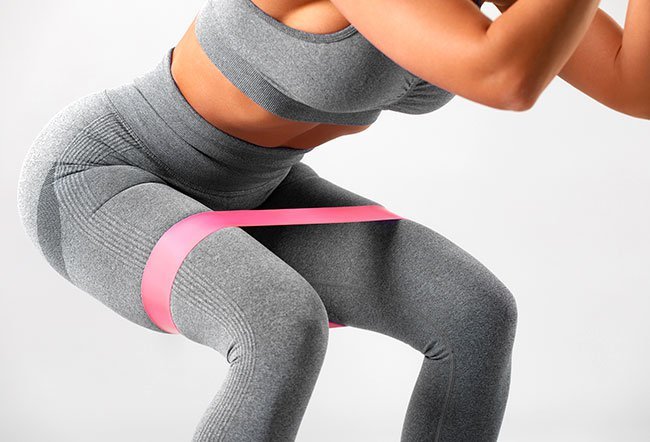
Learn about the benefits of banded squats and 11 ways to do them
Doing squats with resistance bands is a convenient and effective way to build strength in your back, legs, and core.
Squats are a great way to target your glutes and legs. Adding resistance bands makes it more challenging and thus makes these exercises more effective.
Learn about the benefits of banded squats and 11 ways to do them.
What are the benefits of banded squats?
Helps you target your muscles
Resistance bands are effective because they help you control your squat movements so that you can strengthen your back, core, glutes, and abductor muscles.
When you lower into a squat, the bands provide resistance (eccentric movement). They also provide resistance when you rise from a squat (concentric movement).
Works your muscles harder
Bands provide enough resistance to get your muscles working harder. When your muscles work harder, the bands cause your muscles to tear and then repair themselves, which leads to muscle growth.
Improves posture
Banded squats target your glutes as well as your core and back, which your body needs to maintain good posture. Strengthening these muscles can improve your overall balance and stability as well.
Prevents lower back pain
According to some studies, people who experience lower back pain tend to have weak glutes and hamstrings. Doing banded squats can help strengthen these muscles and prevent or reduce back pain.
Good for warming up
Using lower resistance bands at the start of your workout can help warm up your muscles and prepare you for a more intense workout.
What types of resistance bands can you use for banded squats?
- Loop bands: These offer varying degrees of resistance. They are often worn slightly above the knees or ankles and are ideal for full-body workouts.
- Mini loop bands: These are designed to be worn above the knees and are ideal for lower-body exercises.
- Free bands: These can be used for both upper and lower body exercises. You can make a loop out of them or wrap them around your foot.
11 banded squat exercises
1. Deep banded squat
- Stand with your feet shoulder-width apart and wrap the band around your thighs just above your knees.
- Push your hips back and lower yourself until your thighs are parallel to the ground. Slowly stand back up.
- Perform 3 sets of 15 reps.
2. Banded sumo squat
- Stand with your feet slightly wider than shoulder-width apart while wearing a resistance band around your lower thighs. Point your toes slightly outward.
- Inhale and bend at the hips and knees while staring straight ahead, making sure your knees stay in line with your toes. Keep bending your knees until your upper legs are parallel to the floor. Make sure your hips and back stay at a 45-to 90-degree angle.
- Exhale and return to the starting position, lengthening your legs and pushing through your heels.
- Perform 10-12 reps.
3. Banded pulse squat
- Stand with your feet slightly wider than hip-width apart, toes pointing slightly outward, and with the band positioned directly above your knees.
- Extend your hands in front of your chest for balance. Push your hips backward.
- In a controlled motion, bend your knees and lower yourself as far as you can while keeping your chest straight.
- Press through your heels to rise up about 2 inches from the bottom of your squat, then drop yourself back down, pulsing up and down for 5 seconds.
- Perform 10-12 reps.
4. Banded hip bridges
- Lay back on a mat with your feet placed shoulder-width apart and the band around your thighs.
- Keep your knees pointing up and your arms at your sides with your palms down. Your knees, hips, and shoulders should be in a straight line.
- Raise your hips upward and hold before lowering yourself.
- Perform 10-12 reps.
5. Banded clamshell pose
- Lay on your side with your knees bent in front of you at a 45-degree angle. Put the band around your thighs, leaving one end at a 90-degree angle.
- Raise one thigh until your legs form the shape of a clamshell.
- Hold the position and activate your hip, thigh, and pelvic muscles.
- Repeat on both sides for 10-12 reps.
6. Banded donkey kicks
- Start on all fours with your hands under your shoulders and knees below your hips.
- Put the band around one thigh, then slowly lift the other leg and lower it. Your pelvis should be straight, and your navel should be tucked in.
- Perform 10-12 reps.
7. Banded squat walk
- Hold the band over your knees while standing with your feet together. Lower yourself into a squat.
- Hold the squat while you take a step forward with one foot, moving away from your body at a 45-degree angle. Then, repeat with the other foot, switching legs as you walk.
- When you have done your forward reps, go backward, stepping away from your body at a 45-degree angle with each foot until you reach your starting point. Throughout the exercises, keep your head as low as possible.
- Do 5 reps forward and 5 reps backward.
8. Banded side step squat
- Stand with your feet hip-width apart and with a band around your ankles and a dumbbell at chest level in front of you.
- Lower yourself into a squat. For one rep, stay low and take one step to the right and back. Then take one step to the left and back.
- Perform 3 sets of 20 reps.
9. Banded curtsy lunge
- Stand with your feet hip-width apart and a band around your thighs.
- Place your left foot back and to the right, lowering your right thigh until it is parallel to the floor.
- Return to the starting position.
- Do 10 reps on one side, then repeat on the other side.
10. Banded single-leg deadlift
- Place a band beneath your right foot and hold it in place with your right hand. Split your legs so that your right foot is in front and your left foot is in back.
- Shift your weight to your right leg. Bend your right knee slightly and steadily tilt forward at the hips, lowering yourself until your hand touches the middle of your calf.
- Keep your back straight and your core engaged and slowly return to the starting position.
- Do 10-15 reps on one side, then repeat on the other side.
11. Banded kickback
- Start on all fours with a band wrapped around your right hand and the sole of your right foot.
- Lower your right foot behind you while keeping the band straight and slowly return to the starting position.
- Do 10-15 reps on one side, then repeat on the other side.

QUESTION
Walking can maintain your body weight and lower many health risks. True or false? See Answer
How to prevent injury with banded squats
When doing banded squats, it is important to maintain proper form and start with lower resistance, gradually working your way up. Using resistance bands that are too high in resistance can cause injury.
Precautions to take when performing banded squats include the following:
- Before using the band, test it to make sure it can bear full extension from your shoulders to your feet.
- Since banded squats become increasingly difficult as you do more reps, do not rush through reps to the point where you are straining your muscles. If you experience pain, it may be a sign you are overdoing it.
- Perform resistance band squats using suitable grips.
Keep in mind that consistency is an important aspect of any fitness routine. The more you perform an exercise, the easier it will become.
Latest Exercise & Fitness News
Daily Health News
Trending on MedicineNet
Medically Reviewed on 8/8/2022
References
How Effective Are Resistance Bands for Strength Training? https://health.clevelandclinic.org/should-you-try-resistance-bands-for-strength-training/
Strength Training with Resistance Bands- 20 or 40 Minute Routine. https://msuextension.org/wellness/physical-activity/resistance_band.html
9 Types of Squats with Bands. https://www.wellnesswarrior.org/banded-squats/